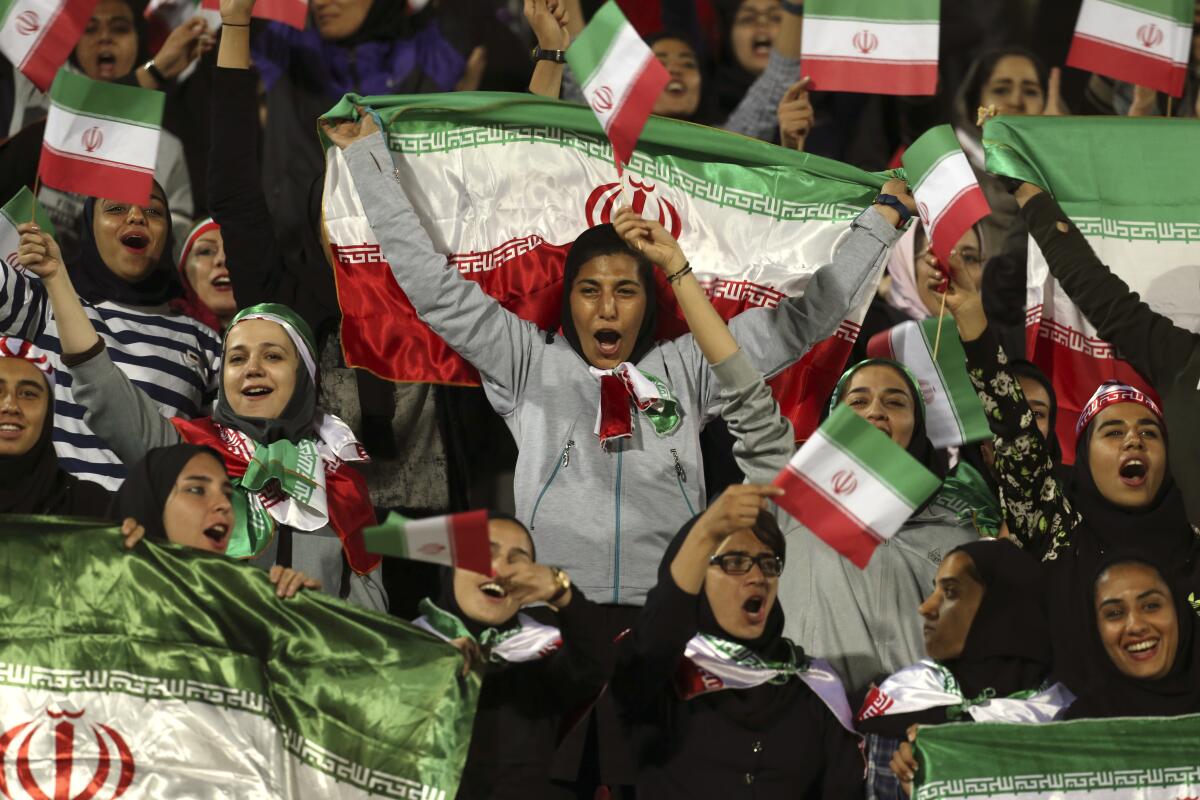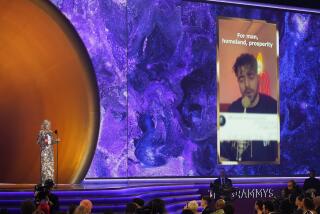Dying after setting herself on fire, “Blue Girl” spotlights Iran’s women’s rights movement

Sahar Khodayari understood the law: Women in Iran are forbidden to enter sports stadiums. But the 29-year-old wanted to watch a soccer match — a benign activity hundreds of thousands of women around the world enjoy.
So, in March when her favorite team was playing, Khodayari did what other Iranian women have done in order to watch live sports events: She disguised herself as a man. Donning a blue wig and long overcoat, Khodayari made her way toward Tehran’s Azadi Stadium, but she never made it inside. A security guard caught her and arrested her. When she found out in early September that she faced six months in prison, Khodayari set herself on fire outside the courthouse where she had been summoned. She died in a Tehran hospital less than two weeks later.
Khodayari’s death has made her the face of a social media campaign pressuring authorities to officially end their long-running ban on females entering stadiums. To many, the young woman has also become a symbol of the Islamic Republic’s restrictive laws governing women. Using the hashtag تا_نیاد_نمیرم#, which means “until she comes I won’t go,” Iranians have flooded social networking sites with messages of outrage, heartache and despair.
“Where men determine women’s fate and deprive them of their basic human rights, there are women who help men in their tyranny, all of us are responsible for detaining and burning girls like this in the country,” reformist lawmaker Parvaneh Salahshouri wrote on Twitter.
Women’s rights activists in Iran said international condemnation after Khodayari’s death casts a spotlight on the country’s burgeoning women’s rights movement spearheaded by young Iranians who are leveraging the power of social media to advance their cause. That movement, activists say, is being fueled by generations of Iranian women who, over the last eight decades, faced repressive laws imposed on them by both the Pahlavi dynasty and Islamic Republic.
“The pressure to change the law and address the patriarchy is from the grass roots. Women will find their way to emancipate themselves,” said Shahla Lahiji, a writer and director of Roshangaran, a publication company that focuses on women’s issues.
Khodayari’s troubles began after she was arrested for trying to watch her favorite soccer team, Esteghlal, play against a team from the United Arab Emirates. She was released on bail and charged with “harming public decency” and “insulting law enforcement agents” for not wearing a hijab, judicial authorities said, according to Iranian state media outlet Rokna News.
Although there’s no law that bars women from watching sporting events in stadiums, it’s been the de facto policy pushed by Iran’s hard-line and religious forces since the revolution in 1979. The reasons for the ban vary — with some politicians claiming such a space is not “suitable” because of the lack of facilities for women, such as bathrooms and segregated women-only seating.
Khodayari was told she faced six months in prison after she was summoned to court Sept. 2. Overcome with emotion, she doused herself in gasoline and set herself on fire, her sister told Rokna News. Khodayari died several days later at Tehran’s Motahari Hospital.
Her death struck a chord in Iran, and it didn’t take long before she was turned into an icon and nicknamed Blue Girl — a reference to the uniform color of her favorite soccer team.
From lawmakers and activists to concerned citizens, Iranians from all walks of life took to social media to express their outrage.
Iranian women behind the Open Stadiums movement — an online campaign that has advocated for the lifting of the ban on women entering stadiums since 2005 — were quick to respond, using their Twitter account, with its more than 3,000 followers, as a platform to spread information and engage in discussions about how the Islamic Republic restricts women’s lives.
“This is an issue that symbolizes how difficult it is to be a woman in Iran and how we lack freedom of movement,” Open Stadiums’ founder said. She asked to remain anonymous because of safety concerns.
It wasn’t long before Khodayari’s death drew international headlines, including comments from professional soccer players and FIFA officials, generating broader conversations about how women in Iran are treated and making the issue difficult for authorities to ignore.
“Our position is clear and firm. Women have to be allowed into football stadiums in Iran. Now is the moment to change things and FIFA is expecting positive developments starting in the next Iran home match in October,” FIFA President Gianni Infantino said in a statement in September.
In the wake of his statement, women were granted some seats to watch an Oct. 10 soccer match against Cambodia, according to social media posts of women showing their tickets.
More than 60% of Iran’s 80 million people are younger than 30, according to CIA World Factbook statistics. And although Facebook and Twitter are technically banned in Iran, most young people know how to bypass censorship by using virtual private networks. There’s also the potential for a large audience; 60% of Iranians use the internet, according to the Washington-based Freedom House 2018 study on internet freedoms in Iran.
In January 2018, another Iranian woman became the subject of a social media campaign named #Where_Is_She after images of her removing her white head scarf and tying it on the end of a stick in Tehran’s crowded Enghelab Square went viral, prompting concerns over her safety and whereabouts.
Her act motivated other women to also remove their head scarves in public. During that time Iran was rattled by the biggest anti-government protests in nearly a decade.
Thousands of Iranians, including women alongside men, demonstrated in cities across Iran to protest high unemployment rates, a crumbling economy and the failure of President Hassan Rouhani’s administration to carry out his promise of relaxing social and political restrictions.
Dozens of women who removed their head scarves were arrested.
Women’s activists said that the fast dissemination of news on social media about Khodayari and the woman who removed her white head scarf highlights how young Iranians are increasingly using the internet as an outlet to express their frustrations and that it has proved to be a helpful alternative to protests when it comes to pressing for change.
“Social media have been heaven for the younger generation. Over the last five years I’ve been seeing a new generation of women fight for their rights by using social media,” said the founder of the Open Stadiums campaign.
Even as women’s rights diminished greatly in the years after the 1979 revolution, women’s activists say significant gains in literacy and education over the last 30 years have helped raise women’s expectations about their role in society. History has also played a role in framing the women’s movement; since the early 20th century, Iran’s leaders have politicized and sought control over women in order to consolidate power, albeit in different ways.
In 1936, the pro-Western Persian monarch Reza Shah Pahlavi created a law that banned women from wearing head scarves — an act that many pious women saw as repressive — and outlawed segregation of the sexes in public places in an attempt to to mirror popular ideas of modernity.
When his son, Mohammed Reza Shah Pahlavi, returned to power after the U.S.- and British-backed coup of 1953 ousted democratically elected Prime Minister Mohammed Mossadegh, he followed in his father’s footsteps by pursuing a series of reforms known as the White Revolution in a bid to retain control and legitimacy.
Restrictions on women intensified after the Islamic Revolution in 1979. But this time, the slightest reminder of the West was shunned. Under Ayatollah Ruhollah Khomeini’s rule, women were forced to cover their hair and they also lost the right to file for divorce and were required to wear loose-fitting clothes. Alcohol was banned as well as music and dancing in public places.
For some women’s activists in Iran, such drastic changes in laws have helped shape their goals. Mahjoub Marzie Rasooli, a 40-year-old women’s rights activist, said the difference in laws concerning head scarves between her generation and her mother’s has shown her the importance of fighting for the right of women to choose whether they want to cover their hair in public.
“We must be free to choose whether we want to follow Islamic code of dress or not,” Rasooli said.
Back in the streets of Tehran, in the days after Khodayari’s death, people gathered for a candlelight vigil outside the courthouse where she had set herself on fire. Her favorite team also held a moment of silence before its practice session.
“Step by step, trench by trench, women activists are advancing toward their goals,” Rasooli said.
Special correspondent Mostaghim reported from Tehran and Times staff writer Etehad from Los Angeles.
More to Read
Start your day right
Sign up for Essential California for news, features and recommendations from the L.A. Times and beyond in your inbox six days a week.
You may occasionally receive promotional content from the Los Angeles Times.







